|
|
|
|
Contact:
Suzuki DR650 Headlight Page

Your motorcycle headlight does two important things. It helps you to see what is in front of you when riding in dark and dim environments and it those in front of you better see you. For those looking to improve nighttime fields of view or need a "look" for their bike, modifying your headlight can give many options for customization and ways to spend you money.
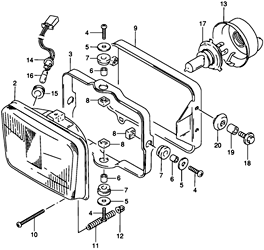
Pre 96 DR650 Headlight Assembly
Multiple Headlights
More headlights mean more light. It is generally better to have two 55 watt lights than one 110 watt light. This both puts out more light as well as makes you more visible on the road. If you are trying to figure out how to run high and low beams, but don't like the dual beam lights available on the market, and don't want to mod a light to use a dual wattage bulb, you can use two lights and wire them so one goes off when in low beam mode. This increases your light options significantly and makes the task of passing road inspection easier.


Buell Motorcycle with Double Headlights
One popular headlight mod is to salvage the dual headlights from a Buell motorcycle and replace the stock light on the DR650 with this setup.
Adding fog lights or driving lights is an easy way to add more lighting and may even emit better lighting than the stock setup on a DR. Brackets can be simple to fabricate with a little bit of creativity or can be purchased from a bike accessory fabricator. See the section on Auxiliary Lighting below.
The downside to adding more lights to a DR650 is that in the event you crash your bike, you are more likely to damage a light if you have them protruding out to the side of your bike.
Buell Light Mod Parts:
M0023.1AJAYT - headlight grill
M1600.1ACMW - black windscreen
Y0421.1AD - headlight
M0645.1ADA - windscreen mount
Related links:
Thumpertalk DR650 Buell Headlight Mod
Larger Headlights
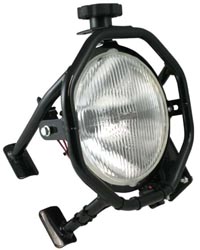
Generally, a larger diameter light is puts out a better light, is easier to be seen and disperses heat better than a smaller diameter light. Large headlights also look cool.
Related links:
Enduro Fairing and Light Combos

KTM EXC Headlight - also in White
There several front fairing replacement options (including fairing/headlights from other bikes) that allow you to bolt on a more factory looking front that will house lights as well as shed some wind from the rider's face. Many of these "upgrades" were designed to allow offroad bikes meet minimum highway requirements for lighting and may not be an upgrade from the stock DR setup in the way of increased trial/road illumination. Some of the more custom setups with projector lights and built in control panels can be quite nice and even Dakar ready.
Unfortunately, many of the aftermarket options available more more are more for athletics and less for performance.
Related Links:
Euro vs American Pattern Lights
There basically two regulatory systems used for vehicle headlights. The SAE standard regulates headlights in the US and the ECE standard regulates headlight use in the rest of the civilized world. ECE E-code lights must have a distinct horizontal "cutoff" line at the top of the beam. Proponents of the US system state that the Euro system does not allow for enough light to illuminate overhead signs and creates short seeing distances at night. Proponents of the Euro system feel that the US system produces too much glare.
Many feel that E-code low beams produce a superior controlled light beam. This can possibly produce as much as four times the light on the road as a standard American SAE sealed beam and twice as much on high beam. Since E-code lamps do have better beam control, you can upgrade your bulbs without offending oncoming traffic as much.
HID Lighting
High Intensity Discharge (HID) lighting can allow for very high intensity light with much lower amp draw than conventional lighting. This can be pretty impressive as well as pretty expensive. HIDs are by far the brightest lights used in offroad racing and halogens look dim in comparison.
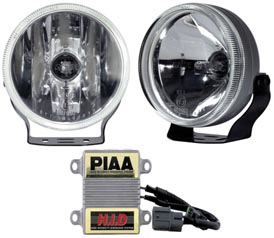
PIAA HID 600
Instead of using a filament that is used in normal motorcycle lights, HID lights use a bulb filled with xenon gas. When ignited with high voltage, electricity arcs between two electrodes in the bulb which excites xenon gases, igniting metallic salts which emit a high intensity white-blue light.
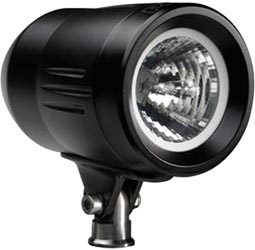
PIAA Cross Country HID
To archive the bright light from xenon, the gas must be initially charged with about 30 amps of electrical current and then only requires 4 or so amps to keep it ignited. To achieve this, HID systems use a ballast which produces around 18-25 thousand volts to jump start the gas to full brightness and then produces around 90 volts to maintain the HID light. This heats up the gas in the HID bulb to around 4100 degree Kelvin compared to 2800 degree Kelvin in a regular halogen bulb.
HID lights are said to produce 3 times as many lumens as a comparable halogen light. Although a 35 watt HID may seem to draw far less wattage than a regular halogen light, it is important to factor in that the ballast alone may use an additional 15 watts of power, causing the entire system to use a total of 50 watts.
HID headlamps produce about 40% more glare than halogen light systems. So to work safely on the road, some countries require that HID lights have a lens cleaning systems and automatic beam leveling control to reduce the high levels of glare common with HID systems. The US doesn't have this standard and HID lights tend to get more complaints than in other counties partially due to the lack of HID regulations and the whiny attitude of Americans in general.
Since HID don't use a conventional filament for lighting, they are more vibration resistant and have a longer lifespan than halogen bulbs. Unfortunately, HIDs don't take kindly to frequent on/off cycling, such as when they are used for high beams on dark winding trafficked roads.
Also note that some of the "HID" systems on the market are actually bright halogen lights and not HID at all.
Plus, HID ballasts produce an electromagnetic field (EMF - sometimes also referred to as electromagnetic pulse EMP) which can disrupt electrical displays, engine computers, GPSs and other electrical devices. Some recommend placing all electrical devices as lease 1 foot from an HID ballast. There are a lot of riders out there that aren't having problems with their HID setups, but there are other rider that have whacko GPSs, electrical displays that don't work and engines that don't run right when their HIDs are turned on.
Related Links:
Daniel Stern Lighting Disadvantages of HID
Daniel Stern Lighting Thinking of converting to HID?
LED Headlights
These are still a new thing for vehicles and tend to be extremely expensive. They tend to draw very little electrical current compared to incandescent lighting of comparable light output, are vibration resistant and produce less heat than regular headlights.
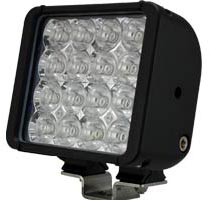
Xmitter LED Light Bar
Most are only good of conspicuity and do little to illuminate the trail or road in front of you. But those that do work, can provide you with some usable light, increased frontal conspicuity and may allow you to run extra electrical accessories such as heated grips and vest if these are replacing incandescent lights.
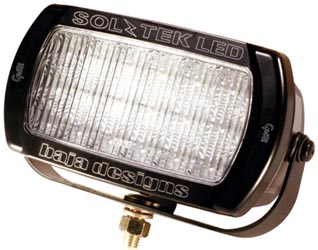
LED Headlights include:
Headlight Modulators
These don't help you see riding obstacles day or night but may help others see you during daylight hours as use at night is generally prohibited. And if you've ever had a bike behind you with modulating headlights, you'll understand just how annoying these can be to others on the road, and therefore how bikes outfitted with these would be harder to miss on the road.
Modulated headlights are legal for use in the US and Canada during daylight hours, but they do draw attention in strange ways. Drivers in front of you may confuse you with an emergency vehicle and slow way down or pull off the road. Likewise, law enforcement officers not familiar with their use may pull you over for impersonating them. In the US, you may wish to carry a copy of the following should you get pulled over for use of modulating headlights:
Excerpt from
Title
49 of the Code of Federal Regulations -
49CFR Section 571.108, Paragraph S7.9.4, entitled "Motorcycle Headlamp
Modulation System"
| S7.9.4 |
Motorcycle headlamp modulation system |
| S7.9.4.1 |
A headlamp on a motorcycle may be wired to modulate either the upper beam or the lower beam from its maximum intensity to a lesser intensity provided that: |
| (a) |
The rate of modulation shall be 240 plus-or-minus 40 cycles per minute. |
|
(b) |
The headlamp shall be operated at maximum power for 50 to 70 percent of each cycle. |
| (c) |
The lowest intensity at any test point shall not be less than 17 percent of the maximum intensity measured at the same point. |
| (d) |
The modulator switch shall be wired in the power lead of the beam filament being modulated and not in the ground side of the circuit. |
| (e) |
Means shall be provided so that both the lower beam and upper beam remain operable in the event of a modulator failure. |
| (f) |
The system shall include a sensor mounted with the axis of its sensing element perpendicular to a horizontal plane. Headlamp modulation shall cease whenever the level of light emitted by a tungsten filament light operating at 3000 degrees Kelvin is either less than 270 lux (25 foot-candles) of direct light for upward pointing sensors or less than 60 lux (5.6 foot-candles) of reflected light for downward pointing sensors. This light is measured by a silicon cell type light meter that is located at the sensor and pointing in the same direction as the sensor. A Kodak Gray Card (Kodak R-27) is placed at ground level to simulate the road surface in testing downward pointing sensors. |
| (g) |
When tested in accordance with the test profile shown in Figure 9, the voltage drop across the modulator when the lamp is on at all test conditions for 12 volt systems and 6 volt systems shall not be greater than .45 volt. The modulator shall meet all of the provisions of the standard after completion of the test profile shown in Figure 9. |
| (h) |
Means shall be provided so that both the lower and upper beam function at design voltage when the headlamp control switch is in either the lower or upper beam position when the modulator is off. |
|
S7.9.4.2 |
|
| (a) |
Each motorcycle headlamp modulator not intended as original equipment, or its container, shall be labeled with the maximum wattage, and the minimum wattage appropriate for its use. Additionally, each such modulator shall comply with S7.9.4.1 (a) through (g) when connected to a headlamp of the maximum rated power and a headlamp of the minimum rated power, and shall provide means so that the modulated beam functions at design voltage when the modulator is off. |
Auxiliary Lighting

There are a lot of options of auxiliary lighting for a motorcycle. These lights can be used to work as brighter and more powerful lights when traveling offroad, they can be used to compliment your headlights with different beam pattern or used to help with day and nighttime conspicuity.
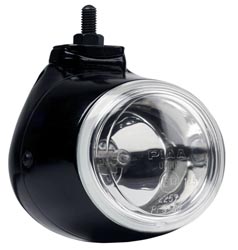
Popular PIAA 910 Auxiliary Light
There all sorts of light combinations used on bikes, and you are only really limited by space, available funds, stator output and imagination. One combo is to add a fog light to the right to illuminate the side of the road and creatures wondering on to the road and to use a driving beam on the left to illuminated as far down the road as you can.
Related Links:
Helmet Lights

Lights can be added to a helmet to help with nighttime illumination. This allows the rider to easily aim his lights at whatever angle he/she wants. It is unfortunately a bit cumbersome and not practical or safe for highway commuting.
Wiring
Anything that creates resistance in your wiring circuit to your lights will create a voltage drop which will result in decreased light output from you headlights. One of the biggest robbers of juice are headlight switches, anther is long a narrow gauge wire.
Relays

Headlight Relay
You can make big gains in light output by simple adding a relay system for your lights. So instead of all the amperage winding it's way through the ignition switch and light switch, it simply goes straight from the batter via larger gauge wires through a low resistant relay, to your light and to a ground via a large gauge wire. This also allow you to easily setup a light cutoff switch that will help with electric startups and blackout driving.
If you are electrically challenged, you can find a simple relay kit ready to plug in to your headlight and battery.
Related Links:
Simultaneous Hi-Lo Beams - Headlight Jumping
If you want to get a little creative with your wiring, you can connect the low and high beam wires with a unidirectional diode. This will allow you to light up both the high beam and low beam filaments in the light bulb simultaneously. The uni-directional diode will allow you to switch back to low beam only when oncoming vehicles flash you. This is best done by wiring the headlight power through two relays that way you don't overload the diode or handlebar switch.
Some light switches allow you to run both high and low beams if you flip the hi/low beam switch to the halfway mark. Again, you are running twice as much current through the switch as it was designed for.
Note that running both filaments simultaneously is going to create a lot of extra heat in your lamp housing. If you are running higher wattage bulbs, and/or using plastic low grade lamps, you may be in for a light failure or even a fire.
Related Links:
Headlight Connector Upgrade
If you are running higher wattage bulbs in your headlights, there is a potential for the headlight connector to melt. If this occurs, you can replace the socket with a heat resistant NAPA ECH LS6235 Headlight Connector.

Related Links:
Upgrading your bulbs with different colors, HID options, and different wattages is the easiest way to modify your headlights.
Related Links:
Bulb Color

In regards to colored bulbs, this may help your bike stand out in traffic - a plus to those wanting to be better seen by other vehicles and a plus to those wanting a "look". Despite the great marketing claims out there, blue tinted bulbs do not increase the amount of light put out by a bulb.
There now seems to be a trend to use yellow lights for bike conspicuity. I'm not sure what this will do for your nighttime illumination, but bikes with bright yellow lights do seem to stand out during the day.
Related Links:
Bulb Wattage
Increasing your bulb wattage is an easy way to increase the amount of light output from your headlight. Since this can be a bit of an annoyance to others on the road, it is often illegal in many countries, provinces and states. To help with problems with the law, there are many bulb options that only increase the wattage for your high beam which can be used when you are not in heavily populated environments and/or where there isn't any oncoming traffic. Plus, if you are using e-code headlights, you may be able to get away with a little higher wattage, as properly aimed e-code lights put more light on the road and less on the face of oncoming traffic than US DOT approved lights.
Higher wattage bulbs tend to be more fragile than standard bulbs but are fun while they last.
Bulb Types
Halogen is the standard bulb used in bikes. These are economical, dependable and easy to find.
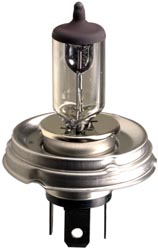
Sylvania H4 ST
Xenon charged halogen bulbs can put out 20% more light than regular halogen bulbs. They tend to have a blue tint than many find keen, but may actually reflect a little more light back at the rider in rainy/foggy/snowy environments.
The following are quality bulbs that may be suitable for stock headlights:
Sylvania H4 ST
Philips Vision Plus
HID Conversion
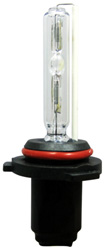
HID Bulb (Ballast also needed)
These tend to be pricey and vary in regards to quality. The webmaster is a little reluctant to fork out this type of cash for a system that requires a bit more hardware and is sensitive to cycling on and off. Those that do use them swear by them, and often have professional mechanics work on their bikes. If you have a lot of extra cash for lighting, you might go with a purpose built HID auxiliary light - or better yet, a combo HID system for long and short range lighting. More info on purpose designed HID lighting is covered above on this page.
HID conversions are pretty straight forward. You buy the kit (the most painful part), install the new bulb, wire in the ballast and figure out where and how to mount your extra electronics.
Of note, the HID bulbs are different in size, shape, orientation, and luminosity distribution than conventional halogen bulbs. Because of this, lamps designed for halogen bulbs will produce improperly-focused beam patterns as well as excessive glare when HID bulbs are used. This is one of the reasons HID light conversions are illegal in many countries and why vehicles with these conversions tend to blind oncoming drivers.
Related Links:
LED Bulbs
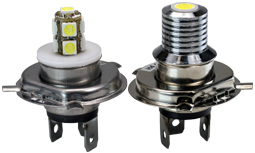
H4 LED Replacement Bulbs
These are generally used for show or conspicuity. LEDs draw little power (even the high output ones) and can be used to illuminate auxiliary lamps to help you get seen - either for vanity or safety. LED replacement bulbs come in all sizes and out puts these days, so it should be easy to find an LED that will mount in your light housing in a variety of colors. If you are crafty, then you can easily modify just about any lamp housing and fit a different bulb than was intended. Again, the light out put from most LEDs is disappointing if you are using it to light up the road in front of you.
Beam Types
Beam types vary greatly from manufacture to manufactures and from design to design. There are a few common beam patterns that will be covered here, but it is important to remember that these patterns vary greatly and generally don't even match the beam pattern displayed on the box the light came in. In fact, some real world beam patterns from manufactured lights are truly horrendous and these lights should only be used for conspicuity purposes and perhaps not even for that.
Driving and Eurobeams
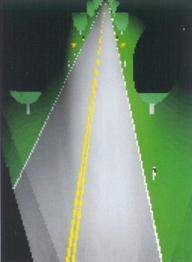
These conical patterns flattened at the top and bottom and are about 110-120 degrees wide and project out around 2000-2500 feet. As the name implies, they are designed for "driving" and may be the most suitable beam type for the primary driving light(s) on a bike. The beam pattern is meant to illuminate a long straight flat road without blinding oncoming traffic.
As mentioned earlier, there is a difference between US DOT and E-code lights. US DOT driving lights are required to throw some light off to the right hand side to illuminate traffic signs. Because of this, they have a sloppier and less focused light pattern. E-code type lights tend to provide more light for the road than US DOT lights.
Pencil Beam
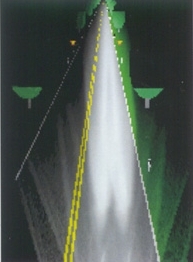
These throw out a very narrow beam and light a reflector up to two miles. Since the beam is so narrow, you may need to use a lot (a dozen) and/or use them with other lamps to be useful. These are used by rally racer in the desert and are usually used as part of an array of lights on the front and on the roof or race vehicles.
Fog Pattern

These have a wide and flat beam pattern that are only good for a couple hundred feet. They are designed to be used in snow, fog and rain to light up the road immediately in front of the vehicle with minimal reflecting light back at the driver. There is some industry myth that yellow penetrates better, gives better contrast and causes less eye strain in bad weather. And in some part of the world, fog lamp must be yellow as per highway law.
Flood Lights

These are similar to fog lights, but without the flattened beam. They are used for slow offroad driving, as corner lights and lighting up work spaces at night. Illumination is only several hundred feet in a wide pattern.
City Light

Optilux Model 2550 with Angel Eye Light Ring
Used in Europe, these are low wattage (5 watt or sometimes just an LED) and are used to mark your vehicle without creating light pollution in populated areas. Newer versions use a led light rings (Angel Eyes) around the headlight.
Shape
Lights basically come in two basic shapes - rectangular and round. Other fancy shaped lights on other bikes are more for show than beam control.

250 Djebel with stock round light
Light emitted from a bulb is easier to control with a circular reflector. And generally, round lamps typically generate better light patterns than rectangular lamps. Round lamps also are easier to find making it easier to find the right size, type and quality of lamp for your bike.
Lamp Design
Parabolic Reflector
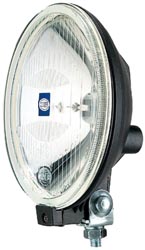
Hella 500 Driving light with Parabolic Reflector and Fluted Lens
Most lamps use a parabolic reflector to reflect light forwards. From there (except with pencil beams) the beam pattern is controlled with a fluted lens. They generally collect around 27% of the light produced by the bulb.
Free Form
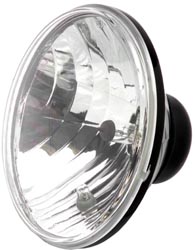
Freeform (FF) lamps use a computer designed reflector with a complicated shape. The shape of the reflector alone shapes from the bulb into the desired light beam pattern. Since the lens is non-fluted, there is less defraction of light as it passes the lens, thus increasing light output. These lamps can collect around 45% of available light from the bulb.
Projector/DE/Polyellipsoidal Lamps
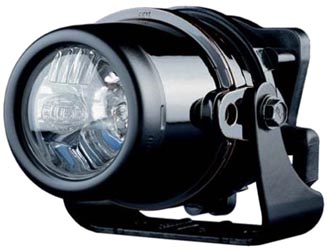
Hella Projector Lamp
Projector lamps us a large surface area free form ellipsoidal reflector to collect light. This is then reflected through a convoluted condenser lens. The design allows the projector lamp to be small in diameter and potentially allow for efficient use of light emitted from the bulb. They can collect as much as 52% of available light from the bulb. Although projector lamps can be very efficient, they also very greatly in quality - with some that are extremely poor in quality.
Brand

Quality of lamps varies greatly between manufacture. If you are using a lamp to actually help you see at night, you should stick with one of the reputable manufactures.
Reputable Light Manufactures:
Please feel free to link to this site so that others can find it. It's easy to link to this site, just copy one of the texts below onto your web page::
Copyright © 2000-2014